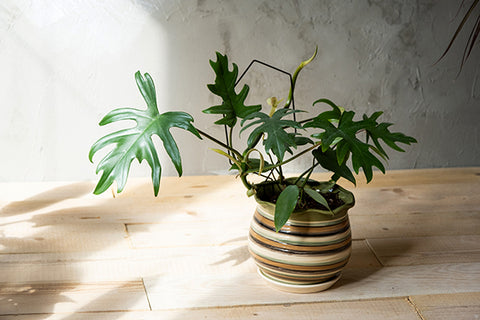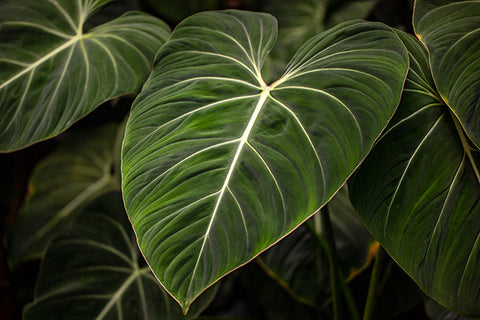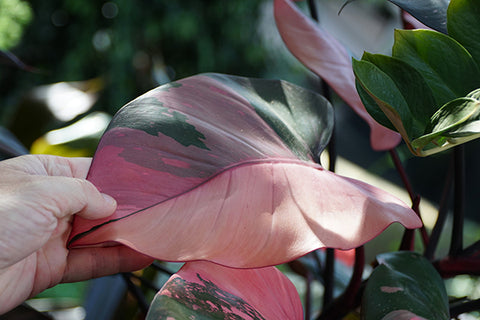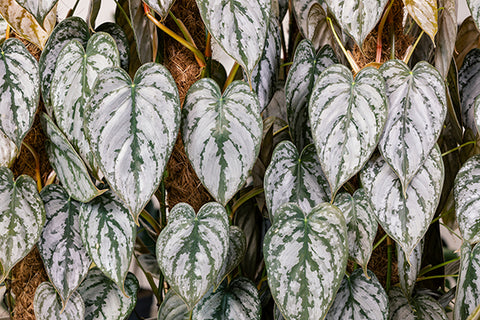Philodendron Care Guide
HOW TO GROW AND CARE FOR PHILODENDRONS
By Emma Kelt, | 27/07/2023
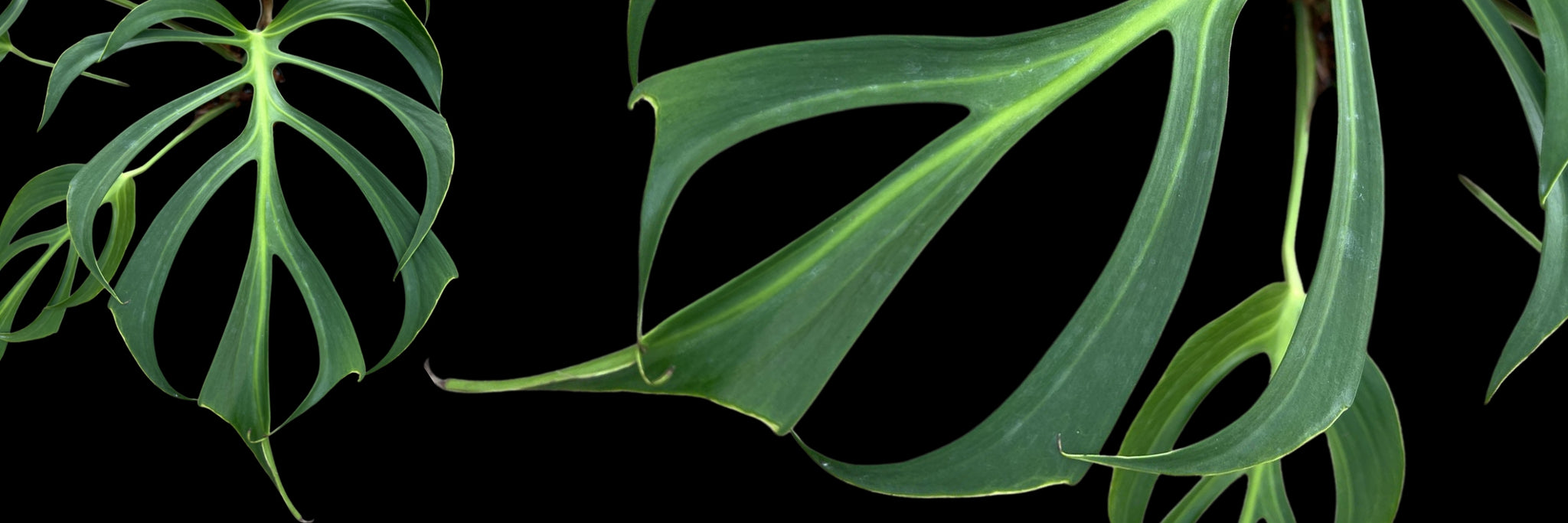
📷 Philodendron Burle Marx Flame, Chalet Boutique
| Common Varieties | Philodendron Hederaceum aka Heartleaf Philodendron, Philodendron brasil, Philodendron gloriosum, Philodendron micans & Philodendron Florida Ghost. |
| Botanical Name | Philodendron spp. |
| Family | Araceae |
| Plant Type | Tropical vine |
| Mature Size | Up to 18 meters tall |
| Light | Bright, indirect light |
| Soil Type | Chunky aroid mix |
| Native Areas | Tropical regions of Central and South America |
| Toxicity | May be toxic to dogs and cats. |
Philodendrons are indigenous to the Americas and the West Indies and contain hundreds of species of attractive foliage plants. These popular houseplants are known for their easy growth habits, and you can choose between vining, climbing and crawling Philodendrons. Vining and climbing varieties can grow several metres tall or long, some requiring some support structure to climb on, such as a grow poles, trellis or around a basket. Crawling varieties grow upright and make excellent container foliage plants.
Our guide will provide all the information you need to keep your Philodendron healthy and content, including tips on light and temperature needs, watering, fertilising, and how to propagate your plant. Let's embark on the journey of Philodendron plant care together!
WELCOME TO YOUR COMPLETE GUIDE TO CARING FOR PHILODENDRONS
📷 Philodendron White Princess, Chalet Boutique
Philodendrons are excellent indoor plants because they are primarily easy care. To keep your Philodendron healthy, replicate its natural tropical environment by providing humidity, warmth, and indirect light. Avoid placing it in direct sunlight as it can burn their leaves. Wiping leaves with a damp cloth regularly will keep them looking their best and allow the plant to absorb sunlight and reduce the chance of pest infestations. Some Philodendrons grow quite large, so check the space you intend to use so that as the plant matures, it will fit.
HOW MUCH LIGHT DOES A PHILODENDRON NEED?
Placing your Philodendron near a window with a soft covering such as a sun curtain or sunshade blind is a good approach to provide indirect light rather than direct sunlight. Direct sunlight can be too intense for Philodendrons and may result in leaf burn or damage. Indirect light, on the other hand, offers the right balance of brightness without the risk of overheating or excessive exposure.
By using a sun curtain or sunshade blind, you can filter the sunlight that enters the room and create a diffused lighting environment for your Philodendron. This helps mimic the shaded conditions that these plants typically thrive in their natural habitats.
Remember to observe your Philodendron and monitor its response to the light conditions. Adjust the curtain or blind as needed to ensure the plant receives adequate but indirect light. Additionally, be mindful of the specific light requirements of your Philodendron species, as different varieties may have slightly different preferences regarding light intensity.
HOW OFTEN SHOULD I WATER A PHILODENDRON?
Philodendrons like their medium slightly moist. Check the top 3-5 cm of soil to see if it has dried out to determine when to water. Too much or too little water can cause the leaves to become limp, so it is essential to water the soil rather than the leaves. Philodendron plants do not tolerate wet soil for long periods and should be kept on the drier side to avoid root rot. Non-climbing varieties are usually more drought-tolerant than vining varieties.
WHAT IS THE BEST POTTING MEDIUM FOR PHILODENDRONS?
The best potting medium for Philodendrons is a well-draining, light, and airy mix. A good blend for Philodendrons should be composed of horticultural charcoal, perlite, premium potting mix, chunky bark, and coco coir. If you are growing your Philodendrons in containers, ensure the pots have good drainage holes to avoid waterlogging.
WHAT’S THE BEST TEMPERATURE & HUMIDITY FOR PHILODENDRONS?
The temperature tolerance of philodendrons varies according to species. Philodendrons prefer temperatures between 15 and 28 degrees Celsius and relative humidity levels between 60% and 80%. Keep them away from cool draughts like those from an air conditioner vent. You may need to increase the humidity around your Philodendron if you live in a dry climate because these plants prefer a moist environment. You can increase humidity by placing plants close together or placing the pots on a pebble tray filled water. Ensure the pot’s drainage holes aren’t submerged in the water as it will cause the plant to be overwatered and rot.
WHAT'S THE BEST FERTILISER FOR PHILODENDRON?
We use the Growth Technology, Foliage Focus on all our Philodendrons from seedlings to mature plants. Follow the bottle instructions to mix the fertiliser to the strength required for the age of your plant.
The GT Focus range sets the benchmark for liquid nutrients. Here's why:
- Each GT Focus product is complete. Unlike most fertilisers, all Focus products contain each of the 12 essential minerals – including Calcium – blended into an easily absorbed liquid concentrate.

- pH buffered to ensure all 12 essential minerals are available to the plant.
- Formulated and balanced to suit the requirements of specific plant types.
- Manufactured using only the highest-grade raw materials and chelated trace elements to ensure effortless absorption by the plant.
- Guaranteed not to contain potentially harmful and ineffective chlorides, urea, sodium and ammonium.
- Easy to use with simple instructions.
- Makes up to 200 litres of working solution.
📷 Philodendron gloriosum, Chalet Boutique
WHAT ARE COMMON PHILODENDRON PESTS, AND HOW DO YOU TREAT THEM?
There are no serious pest or disease problems with these plants. However, they are vulnerable to common houseplant pests such as aphids, mealybugs, scale, thrips, and spider mites.
Philodendrons are susceptible to most common pests such as mites, scale, mealybugs, aphids, and thrips. They are also susceptible to rust fungus, you can read about the treatment of rust by clicking here. To treat the common pests, it is essential to inspect your plant regularly and act as soon as you notice any signs of infestation. Keep your Philodendron away from other plants that may have pests to prevent problems. If you do have pests, you can treat them with insecticidal soap, neem oil, and horticultural oil. Make sure to follow the directions on the label and apply the treatments as needed. To ensure the pests are eliminated, you may need to repeat the treatments a few times. Additionally, beneficial insects such as ladybugs, lacewings, and parasitic wasps can be effective biological control against these pests. You can read about more treatments here.
HOW TO PROPAGATE A PHILODENDRON
If your philodendron vines become too long or leggy, you can safely prune them with sterile pruning shears or scissors. The best seasons for this are spring and summer. You can also remove yellowing leaves or spindly growth as needed. When cutting, always cut just above a leaf node. You can save the cuttings for future propagation.
Philodendron propagation is generally simple and can be accomplished through stem cuttings or division depending on the species. Early spring is the best time to propagate because the days are getting longer.
You will need sterile pruning shears or heavy-duty scissors, your propagation medium of choice, a pot or container and a rooting hormone. Cut a 15cm section of the stem and place it in sterile container to dry out before placing into your propagation medium.
You can use rooting hormone to increase your chances of success, but it is not required.
Some Philodendrons can be divided easily when they begin to form plantlets. To do this, water the plant the day before you split it. This will help prepare the plant for the trauma of being divided. You will need a sharp knife, potting mix, and a new pot. Start by removing the plant from its current container and placing it on a flat, steady surface. Loosen the root ball with your fingers, then use a knife to cut through dense roots if necessary. Pull off the plantlet with its roots and immediately replant it in a fresh, moist potting medium. Use the opportunity to refresh the original plant in new potting soil or a slightly larger container.
📷 Philodendron 'Pink Princess', Chalet Boutique
WHEN DO YOU NEED TO REPOT A PHILODENDRON?
The best time to repot a Philodendron is late spring or early summer. Begin by selecting a pot one size larger than the current one. Remove the plant from its container and repot it with new soil. Make sure the new pot has plenty of drainage holes in the bottom. Water the plant thoroughly once it has been placed in the new container. It is time to repot the Philodendron if the roots begin to poke through the drainage holes.
ARE PHILODENDRONS TOXIC TO PETS AND CHILDREN?
Most Philodendrons are toxic to pets and children if ingested. The plant contains calcium oxalate crystals, which can cause irritation and swelling of the mouth and throat if ingested. If ingested, it is recommended to seek medical attention immediately.
📷 Philodendron brandtianum, Chalet Boutique
Common Types of Philodendrons:
- Philodendron balaoanum
- Philodendron bipennifolium
- Philodendron cordatum
- Philodendron domesticum
- Philodendron erubescens
- Philodendron gigas
- Philodendron gloriosum
- Philodendron glorious
- Philodendron hastatum
- Philodendron hederaceum
- Philodendron jacquinii
- Philodendron mamei
- Philodendron mayoii
- Philodendron mcdowell
- Philodendron melanochrysum
- Philodendron micans
- Philodendron squamiferum
- Philodendron verrucosum


